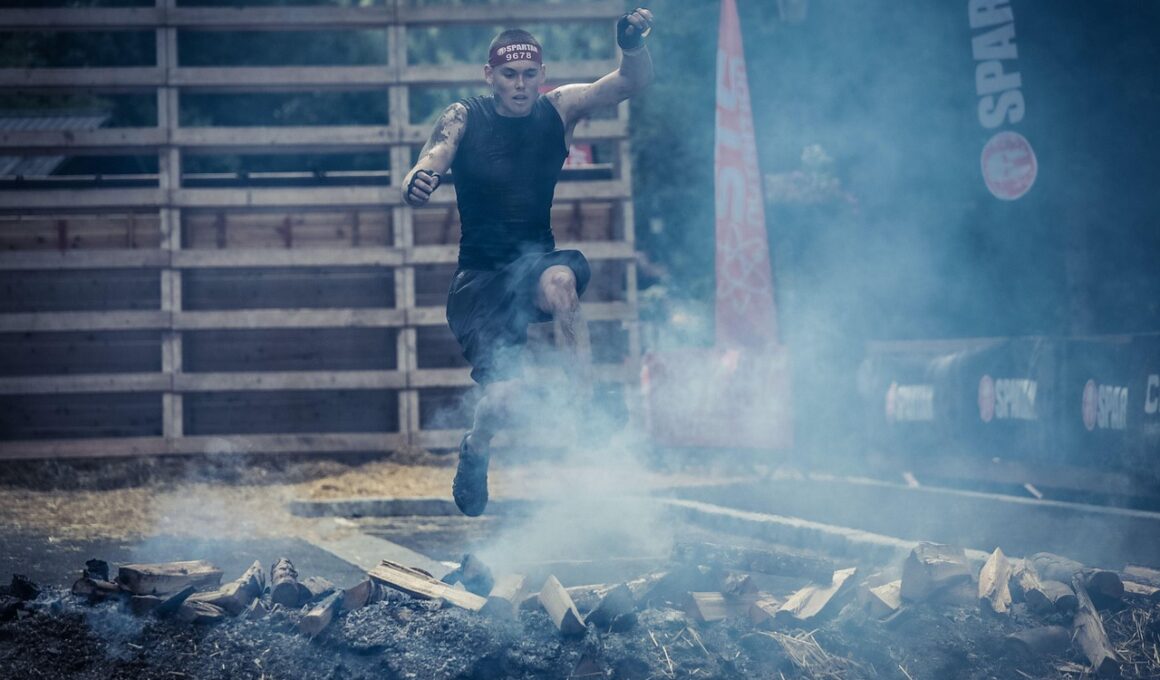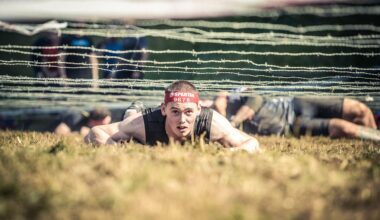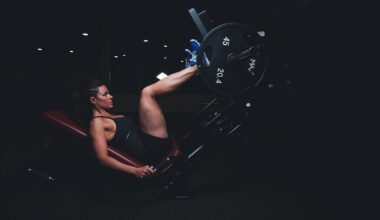The Evolution of Footwear for Obstacle Course Racing
Footwear technology in Obstacle Course Racing (OCR) has advanced significantly in recent years. Initially, racers relied on traditional running shoes, which often failed to provide adequate grip and protection. These shoes lacked specialized designs necessary for navigating uneven terrain, slippery slopes, and various obstacles. With the growing popularity of OCR, shoe manufacturers have invested in research to create footwear that meets the unique demands of competitors. Innovations now focus on materials, traction, and overall performance during events that challenge endurance and agility. Brands like Altra and Inov-8 have recognized the need for lightweight designs that can enhance speed without compromising safety. Additionally, shoes with quick-drying capabilities are becoming essential, given the wet environments often found in these races. Incorporating breathable materials not only enhances comfort but also reduces the risk of blisters. As racers push themselves to the limit, proper footwear becomes a critical component of their training and performance strategy, reflecting the commitment of both athletes and brands to evolve and succeed in this dynamic sport. Overall, the evolution of OCR footwear represents a blend of technology and athlete needs, paving the way for a new generation of high-performance shoes.
Racers often seek specific features in their OCR footwear to ensure optimal performance during competitions. Key functionalities include superior traction, flexible outsoles, and lightweight constructions. Manufacturers often implement cutting-edge technologies to enhance grip, such as strategically placed lugs on the soles, which improve traction on various surfaces. A flexible outsole is crucial, allowing the foot to move naturally over obstacles while maintaining stability. Additionally, lightweight materials help reduce fatigue, enabling competitors to maintain their speed throughout challenging terrains. The integration of energy-returning foams, such as EVA or proprietary blends, provides the necessary cushioning without adding heft. Another aspect gaining attention is the shoe’s drainage system, which helps expel water quickly to keep the feet dry during muddy runs. These features collectively address the athletic need for both performance and comfort, ensuring that the footwear does not hinder their progress. Furthermore, aesthetic elements are also crucial, as personal style often influences consumers’ choices. Ultimately, OCR footwear continues to evolve alongside the sport itself, becoming increasingly sophisticated to support aspiring athletes in achieving their best performances.
Importance of Grip and Traction
One of the most crucial aspects of OCR footwear is grip and traction, essential for navigating various obstacles and terrains encountered during competitions. Traditional running shoes typically struggle in these conditions, often yielding poor performance on slippery or uneven surfaces. However, OCR shoes are specifically engineered with advanced tread patterns and different rubber compounds to enhance grip and traction. The careful design of these shoe soles ensures optimal performance, whether racing through mud, rocks, or logs. High-friction materials, such as stick rubber, allow runners to maintain stability while climbing walls or tackling steep descents. Tracked lugs provide additional bite during sprinting, ensuring competitors can push themselves to the limit without losing traction. The evolution in grip technology has moved from simple patterns to more complex geometries that account for every aspect of a racecourse. This concentrated focus on traction enables athletes to perform better overall, reducing the risk of slips and falls while providing confidence as they tackle challenges. Consequently, the importance of grip and traction cannot be overstated, serving as the foundation on which racers build their strategies and push themselves to new heights.
As the science of materials continues to evolve, so too does footwear technology in OCR. Manufacturers are increasingly exploring innovative materials that offer improved durability and performance. Lightweight synthetic fabrics, such as ripstop nylon, are commonly used to create shoes that can withstand the rigors of extreme sports without deteriorating quickly. Moreover, water-resistant and breathable materials are crucial for comfort during prolonged wear in unpredictable weather conditions. The inclusion of protective toe caps and reinforced uppers helps guard against impact during obstacle navigation, reducing injury risks. Sustainable materials are also gaining traction, with brands actively seeking eco-friendly alternatives to traditional shoe components. This progressive thinking not only benefits the environment but also appeals to a growing number of eco-conscious athletes and consumers. The continuous pursuit of new materials and technologies ensures that OCR footwear remains at the forefront of performance innovation. By staying dedicated to research and development, brands can create shoes that meet the ever-evolving demands of athletes while also catering to their comfort and style preferences. This commitment reflects the dynamic edge of the OCR community and its relentless pursuit of excellence.
Impact of Athlete Feedback
Another significant factor contributing to the evolution of footwear technology in OCR is the invaluable feedback from athletes and competitors involved in the sport. As racers express their experiences and needs, manufacturers gain insights into performance gaps and areas for improvement. Such feedback often leads to tangible design adjustments and innovations tailored to the athletes’ demands. Focus groups, testing sessions, and collaboration with elite OCR athletes create opportunities for performance-driven enhancements that address specific pain points. For instance, racers have reported preferences for lighter, more agile shoes that can adapt to different terrains effectively. Through ongoing dialogue with athletes, brands can refine their product offerings, introducing improved cushioning, ankle support, and adaptability features. Furthermore, community engagement helps manufacturers stay connected to the racer’s journey and understand various skill levels, from beginners to elite competitors. This vital exchange allows for the creation of shoes that resonate with the needs of diverse athlete backgrounds, enhancing performance across the board. Ultimately, the integration of athlete feedback represents a collaborative effort, fostering innovation while ensuring footwear continues to aid athletes in conquering obstacles with confidence.
Performance testing is a critical component in the development of OCR footwear, focusing on durability and functionality. Shoe manufacturers conduct rigorous evaluations to ensure their products meet the challenges of extreme racing conditions. These tests often involve simulations of various terrains, obstacles, and weather scenarios that racers encounter during actual competitions. By employing metrics such as slip resistance, wear-and-tear analysis, and impact absorption measurement, manufacturers refine their designs until they achieve optimal results. Prototypes undergo real-world testing with elite athletes who provide actionable insights regarding fit, comfort, and performance. It is through this meticulous evaluation process that innovations can transition from concept to market-ready products. Additionally, performance testing contributes to building consumer trust as athletes share their experience in various competitions. Word-of-mouth and community reviews often guide purchasing decisions, driving manufacturers to target high standards consistently. Ultimately, effective performance testing reinforces a brand’s commitment to quality and safety, providing the foundation for athletes to select footwear that empowers them during demanding races. As OCR continues to grow worldwide, so too does the importance of robust testing programs that prioritize athlete needs while incorporating the latest technology.
Future Trends in OCR Footwear
Looking ahead, several exciting trends are emerging within the landscape of OCR footwear technology. Advancements in 3D printing and manufacturing processes are likely to revolutionize how shoes are produced, allowing brands to create highly customized products tailored to individual athlete needs. This innovation may include personalized fit options and specific performance enhancements based on individual biomechanics. Additionally, smart technology, such as embedded sensors, holds the potential to provide real-time performance data and feedback, enhancing training modalities and race strategies for athletes. Sustainability will also remain a priority as consumers increasingly demand eco-friendly alternatives, prompting brands to explore renewable materials and recycling initiatives within their production practices. Moreover, the integration of innovative locking systems and modular designs might provide flexibility and adaptability, allowing athletes to modify their shoes for various race conditions instantly. These trends reflect a broader movement towards combining technology and sustainability within the realm of sports footwear. Ultimately, the future of OCR footwear promises to be dynamic, incorporating cutting-edge advancements while continuing to prioritize performance, comfort, and the unique requirements of athletes as they navigate challenging courses.
In conclusion, the evolution of footwear technology in Obstacle Course Racing showcases the rapid advancements made since its inception. Racers have witnessed significant changes in shoe design, materials, and functionalities, all aimed at enhancing performance on challenging terrains. As footwear technology evolves, it becomes increasingly aligned with the needs of athletes, ultimately revolutionizing the racing experience. Improvements in grip, traction, and overall comfort have transformed how racers approach competitions, allowing them to tackle obstacles with confidence and agility. The collaborative efforts between manufacturers and athletes have proven essential in driving innovation forward, creating a fruitful cycle of dialogue and enhancement that benefits all stakeholders in the sport. As new technologies emerge and sustainability becomes a priority, the OCR community can anticipate even more significant strides in footwear design. Additionally, the commitment to continuous improvement in performance testing and athlete feedback will further solidify the role of footwear as a critical aspect of any OCR competition. Athletes can look forward to shoes that not only support but also elevate their racing experiences, ultimately shaping the future of Obstacle Course Racing as we know it.


